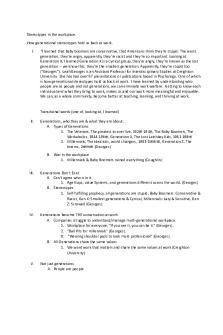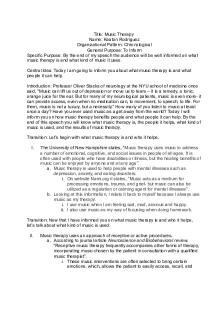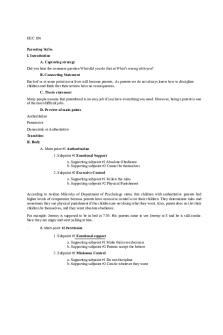Informative Essay Bolivar PDF

| Title | Informative Essay Bolivar |
|---|---|
| Author | Thomas Marin |
| Course | Writing and Rhetoric 1 |
| Institution | Florida International University |
| Pages | 5 |
| File Size | 88.2 KB |
| File Type | |
| Total Downloads | 83 |
| Total Views | 152 |
Summary
This is an example of an informative essay...
Description
Thomas Marin Informative Essay Final Draft Father and Son Is well known in the canon of Venezuelan history that our greatest and most influential figure, Simon Bolivar, never had any children. He was once married briefly with a Spanish aristocrat that he courts for two years while studying in Spain. He wed Maria Teresa del Toro when he was nineteen in 1802. Eight months after returning to Venezuela with him, she died of yellow fever. Bolivar was so affected that his family feared for his state of mind and his life, he also swore to never marry again. He kept his promise, and that is why we don’t have an official lineage of The Liberator. Growing up, we get this notion about the personal life of Bolivar over and over. We get taught all his great feats and his almost godlike image is rarely stained by a discourse that never changes. Does it? If we go outside of the “canon” of what Venezuelan kids get taught through primary and high school, but then you read some books and hear some teachers talk about the subject. He said he would never marry again, he never took a vow of celibacy. Did he have a son? According to historians and their research; No, he didn’t have a son; he probably had many. Some attribute twenty-nine children to the hero. It seems like Bolivar was kind of a womanizer and had many lovers around South America and Europe. The misconception of Bolivar having no descendants comes from the treatment of his person as morally faultless. The schools don’t go beyond his marriage and his friendships, but his lovers were actually important figures that more than once defined the outcome of several important moments in the history of Venezuela. Little is known about the children he had and what became of them. Regardless of this, several authors, historians, and journalist have found information that with certain truth can give us an idea of how many children did he had, and with whom. The
journalist Carlos Goedder claims that: “Officially recognized, there was no child of the Liberator, but as mentioned before, there are several indications that suggest multiple offspring.” He later says, “There are only two essentially certain children”. One of these children was Miguel Simon Camacho (1819 – 1898), son of the Colombian Ana Rosa Mantilla, who met Bolivar while he was in Bucaramanga. The child was passed to Bolivar’s sister Maria Antonia and was adopted and raised by her daughter Valentina Clemente and her husband Gabriel Camacho (from whom Miguel took his last name). It is said he met his father in Peru, but established in Quito during his adulthood, he had two children with a lady from Ibarra (they never married). Ecuadorian President Eloy Alfaro was present during his funeral. (Goedder) The other essential child was Jose Antonio Costas, conceived with the Bolivian Maria Joaquina Costa Almendras in 1826 while he was in Potosi. She was the wife of the Argentinean official Hilarion Quintana, who when learning of the affair left his Maria Joaquina (He didn’t recognize the child she had for obvious reasons). Bolivar told his friend, the French General Louis Peru de Lacroix of the existence of a son he had in Potosi. It is said he reunited with his father thanks to Jose Miguel de Velasco (who later would be president of Bolivia) who took him and her mother to Lima, where they met each other. Jose “Pepe” Costas grew up in Potosi where her mother worked doing handicraft and running a school until her death in 1877. Pepe was known as an elegant man who enjoyed singing and playing the guitar during festivities. (Goedder) A certificate of marriage dated on October five of 1895 from the parish of a little town called Caixa, (which is really close to the city of Potosi) was recently divulged. In this certificate, Bolivar appears mentioned as the father of the groom. Several authors had written of this circumstance several times through the years claiming to have seen the document and even interviewing the great-grandson of Pepe Costas (Elias Costas) in 1975. (“Hallan…”)
Another child attributed to Bolivar is the one he allegedly has with Louise Jeanne Nicole Arnalde Denis de Trobiand or Fanny du Villars, which is how history knows her. She was a lover Bolivar had in his youth while he lived in France from 1804 to 1806. They exchanged correspondence for the rest of their lives (In fact the last personal letter accredited to Bolivar was directed to Fanny in 1830). In a lot of this letters the son of fanny and Bolivar’s godson, Simon Briffard. He is considered by many to be his son. (Goedder) There is another French lost child that is believed to be Bolivar’s. Flora Celestine Therese Henriette Tristan y Moscoso Lesnais (1803-1844) was a French writer, socialist and feminist activist, considered to be one of the great founders of the third wave of feminist. She wrote several literary works; Peregrination of a Pariah (1838) a novel about the foundation of the Peruvian Republic, the critical pieces Promenades in London (1840), The Workers’ Union (1843) and The Emancipation of Women (1846). She also edited and translated several letters from Simon Bolivar, who visited her house frequently when she was a kid. It is believed that her mother, Teresa Laisney, met Bolivar before he married and that she consoled Bolivar after the death of his only wife. Her “father” was a colonel of the Spanish Navy called Mariano TristanMoscoso, he was sixty when he died in 1807, Flora was five. She was not recognized as his daughter, which prevented her from claiming her inheritance. She was the grandma of famous French post-impressionist artist Paul Gauguin (Which curiously would make him the greatgrandson of Bolivar). She was the protagonist, alongside her grandson Paul, of the novel The Way to Paradise of Peruvian Nobel-winner writer Mario Vargas Llosa, who describes her as “reckless and romantically righteous”. She died of typhoid fever in 1844, in Bordeaux, she was 44. Andre Breton would later say about her that: “Perhaps there is no feminine destiny that
leaves, in the firmament of the spirit, such a long and luminous seed”. She is by far the most famous and interesting of Bolivar’s lost children. (Vasco) (Colmener) (Barba).
Works Cited Barba, Monserrat. “Los Libros Mas Importantes de Flora Tristan” Aboutespanol. 15 Feb 2017 https://www.aboutespanol.com/los-libros-mas-importantes-de-flora-tristan-1271750 Colmener, Alvaro
“Madre
del
Femenismo
Moderno”
El
Mundo.
17
Jul.
2008.
http://www.elmundo.es/yodona/2008/07/17/actualidad/1216306704.html Goedder, Carlos. “Simón Bolívar, sus Mujeres e Hijos.” Diario Exterior. 24 Jun. 2014. https://www.eldiarioexterior.com/articulo.asp?idarticulo=43989&mes=&ano. Herrera Luque, Francisco. Bolívar de Carne y Hueso. Ateneo de Caracas, 1980. Vasco,
Bernardo.
“Los
Cuatro
Hijos
de
Bolivar”.
El
Tiempo.
07
Jun.
1992.
https://www.eltiempo.com/archivo/documento/MAM-131706 “Hallan documento que certificaría que Simón Bolívar tuvo un hijo en Bolivia” El Espectador. 20
Sep.
2016
https://www.elespectador.com/noticias/actualidad/hallan-documento-
certificaria-simon-bolivar-tuvo-un-hij-articulo-655944....
Similar Free PDFs

Informative Essay Bolivar
- 5 Pages

Simon Bolivar Essay
- 3 Pages

Simon Bolivar – carta da Jamaica
- 6 Pages

Valores DE Simon Bolivar unefa
- 14 Pages

Notas santiago bolivar
- 3 Pages

Informative Speech
- 3 Pages

Informative speech
- 3 Pages

Informative Speech
- 3 Pages

Informative speech
- 4 Pages

Informative 2Reflection
- 1 Pages

Informative Speech
- 3 Pages

INFORMATIVE SPEECH
- 6 Pages
Popular Institutions
- Tinajero National High School - Annex
- Politeknik Caltex Riau
- Yokohama City University
- SGT University
- University of Al-Qadisiyah
- Divine Word College of Vigan
- Techniek College Rotterdam
- Universidade de Santiago
- Universiti Teknologi MARA Cawangan Johor Kampus Pasir Gudang
- Poltekkes Kemenkes Yogyakarta
- Baguio City National High School
- Colegio san marcos
- preparatoria uno
- Centro de Bachillerato Tecnológico Industrial y de Servicios No. 107
- Dalian Maritime University
- Quang Trung Secondary School
- Colegio Tecnológico en Informática
- Corporación Regional de Educación Superior
- Grupo CEDVA
- Dar Al Uloom University
- Centro de Estudios Preuniversitarios de la Universidad Nacional de Ingeniería
- 上智大学
- Aakash International School, Nuna Majara
- San Felipe Neri Catholic School
- Kang Chiao International School - New Taipei City
- Misamis Occidental National High School
- Institución Educativa Escuela Normal Juan Ladrilleros
- Kolehiyo ng Pantukan
- Batanes State College
- Instituto Continental
- Sekolah Menengah Kejuruan Kesehatan Kaltara (Tarakan)
- Colegio de La Inmaculada Concepcion - Cebu



